























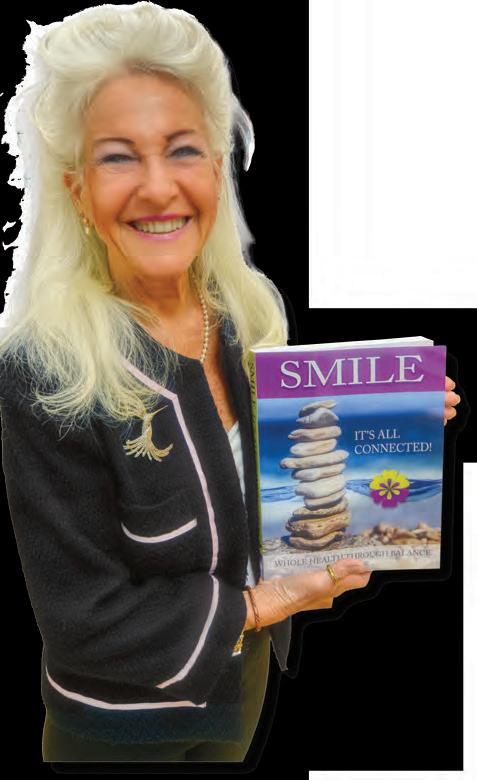






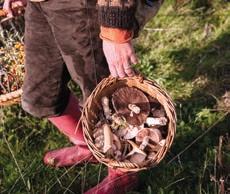


Publisher
Tracy Patterson, BSc, MES
Design & Production Vegetorium, LLC
Copy Editor Sara Gurgen, MS
Digital Platforms
Carolyn Coogan Locable
Natural Awakenings – Phoenix 3260 N Hayden Rd, Ste #210 Scottsdale, AZ 85251
Tracy@NaturalAZ.com NaturalAZ.com
CEO
Kimberly B. Whittle
National Editor Sandra Yeyati
Editor Brooke Goode
Copy Editor/Proofing Melanie Rankin
Layout Flip180 Media
Cover image
Philippe Degroote/CanvaPro
© 2024 by Natural Awakenings. All rights reserved. Although some parts of this publication may be reproduced and reprinted, we require that prior permission be obtained in writing. Natural Awakenings is a free publication distributed locally and is supported by our advertisers. Please call to find a location near you or if you would like copies placed at your business. We do not necessarily endorse the views expressed in the articles and advertisements, nor are we responsible for the products and services advertised. Check with a healthcare professional regarding the appropriate use of any treatment.

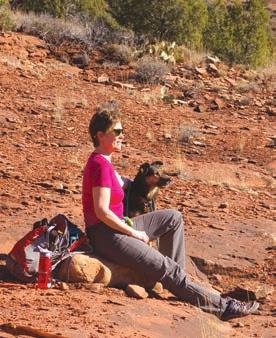
The article in this month’s Conscious Eating department, “Marvelous Mushrooms: Celebrating a Culinary Powerhouse,” on page 20, reminded me of a mushroom festival I attended years ago.
I knew next to nothing about mushrooms, other than a couple of varieties I often bought at the grocery store were very tasty. As I was talking to people in this huge room filled with every kind of mushroom imaginable, I thought, “Who knew that people have fungi as a hobby, and that it is such a vast subject requiring so much knowledge?!” It was particularly interesting (and a little scary) to learn that two species can look almost identical, and yet one is edible and the other poisonous—in other words, one should know their mushrooms before sampling these delicacies along the trail.
One species I learned about at the festival, often found along the trails where I lived, was the fly agaric mushroom (Amanita muscaria). They have whitish stalks with white-spotted brightred caps. What I didn’t know is that they are known for their hallucinogenic properties, but they aren’t often eaten because they have unpleasant side effects. All I could think about when I saw them was that they looked like little villages, and I expected to see tiny people coming out of these red-capped “structures.” In fact, this fairy-tale scene triggered a memory of old Disneyland cartoons, particularly Snow White and the Seven Dwarfs. And, no, I did not eat any before these thoughts popped into my head!
After the festival, I decided I would leave the mushroom picking up to the experts. I stick to grocery stores and farmers markets, both of which carry an assortment of mushrooms, these days. It’s amazing how the various types impart their wonderful flavors to so many dishes and provide us with health benefits as well. My latest thought is to try a mushroom drink, but I’m just in the research stage so far!


Please note that all deadlines (advertising and editorial) are the 10th of the month prior to the edition being published. For example, September 10 is the deadline for all October edition submissions.
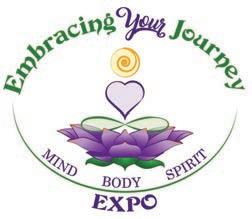
The Embracing Your Journey Expo, a popular recurring event in Phoenix’s holistic, wellness and metaphysical community, will take place on Saturday, September 21, from 10 a.m. to 5 p.m. at the New Vision Center for Spiritual Living. This day-long gathering invites attendees to explore a range of alternative health practices, products and services offered by more than 35 vendors.
Coinciding with the Fall Solstice, the expo offers a unique opportunity to celebrate prosperity and abundance while discovering what the Valley has to offer in holistic wellness and metaphysical practices. Visitors can engage with vendors providing such services as massage, reiki, sound healing and readings (tarot, Akashic Records and angel), along with goods like essential oils, natural bath products and affirmation products.
Cost: $5 in advance or at the door; free for children 10 and under. The New Vision Center offers free parking. Advance ticket purchases come with a free gift upon arrival, and the first 50 paid guests will receive a swag bag. Location: 18010 N. Tatum Blvd. To purchase tickets, visit eyje09212024.eventbrite. com. For information, vendor profiles and lecture schedule, visit EmbracingYourJourneyExpo.com. See ad, page 35.
Advertorial

The findings of a study on the long-term effects of diet were presented at the June 2024 meeting of the American Society for Nutrition, in Chicago. The study tracked diet and cognitive abilities of more than 3,000 adults enrolled in a British survey since 1946. The participants’ diet was analyzed at five points in time, and their cognitive ability at seven points. The researchers found that higher dietary quality was closely linked with greater cognitive ability, including working memory, processing speed and general cognitive performance. Those with the highest cognitive abilities over time ate more vegetables, fruits, legumes and whole grains, and less sodium, added sugars and refined grains. Only 8 percent of participants with low-quality diets sustained high cognitive abilities. The results of the study suggest that the cumulative effects of diet are linked to how sharp the mind is as we age.


Exercise creates microscopic tears in muscle tissues, which the body repairs, and each repetition of this cycle allows muscles to grow back stronger. Contrast water therapy (CWT) is a post-workout recovery method that involves placing sore muscles in alternating hot and cold baths in succession. Data examined from 13 studies and published in a 2013 PLOS ONE review showed that CWT resulted in significantly greater improvements in muscle soreness and reduced strength loss at six, 24, 48, 72 and 96 hours after exercise, compared to rest without any other post-recovery approach. The results of CWT were comparable to other muscle recovery interventions such as cold-water immersion, warm-immersion, compression and stretching.

While food addiction is not considered an official diagnosis, some people have a hard time controlling the amount of highly processed foods they consume. In research published in the journal Gut, scientists analyzed the microbiome bacteria of mice and humans with food addictions. They found that the bacteria in mice and humans with food addictions were different from their counterparts with a healthy food relationship. The food-addicted groups had lower levels of the beneficial Blautia bacteria and high levels of the detrimental Proteobacteria in their microbiomes. When the researchers increased the Blautia bacteria levels in the mice that had become compulsive eaters, the compulsive behavior stopped. While a correlation between the microbiome makeup and eating patterns has been identified, more research is needed to understand whether that relationship is a cause or a marker for compulsive eating.
Lupus is an autoimmune disease in which the immune system mistakenly attacks healthy tissue, damaging joints, skin, muscles, connective tissue and major organs such as the kidneys, brain and heart. According to the Lupus Foundation of America, an estimated 1.5 million Americans have lupus, with nine out of 10 being women. Researchers at Northwestern Medicine and Brigham and Women’s Hospital, in Boston, say they have identified the root cause of lupus. In research reported in the journal Nature, the scientists identified a molecular defect that promotes the immune response in lupus, as well as a way to reprogram the lupuscausing cells to correct the imbalance in the immune response. Work continues to find a safe and effective way to deliver these molecules to the body for reprogramming.


A group of international scientists have discovered a breeding population of Asian giant softshell turtles on the banks of India’s Chandragiri River. According to an article in the conservation journal Oryx, people from the local community reported sightings and aided in the live release of turtles caught by fisherman.
The softshell turtle has frog-like facial features and is native to the rivers of South and Southeast Asia. They can grow to be more than three feet in length and weigh more than 200 pounds. These turtles are classified as critically endangered on the International Union for Conservation of Nature’s Red List of Threatened Species. The turtle’s population has been in decline due to habitat destruction, over-harvesting for meat and harm from fishing gear. This discovery offers hope for future conservation efforts to help the turtles thrive.

Since 2017, Northwest Siberia has experienced 17 ground explosions, resulting in holes that are more than 20 feet across by 65 feet deep and filled with dark, peaty water. Speculation about the cause of these so-called black holes ranges from weapons testing and meteorites to sinkholes. A team led by the University of Oslo, in Norway, theorized that the holes are craters caused by warming Arctic temperatures, which weaken the frozen soil so much that fossil pockets of gas explode through its surface.
While thawing ice was long suspected as a cause, this theory explains why the holes are found only in specific areas of Russia, over the remains of some of the oldest continental crust found on Earth. In those areas, hot natural gas seeps up through geological faults that had been trapped by sediment caps of old frozen lakes. As the temperatures in Siberia have warmed, these caps are more likely to rupture, causing sudden gas explosions that could have formed the craters.
Inside a regular material that conducts electricity, electrons encounter resistance and lose energy in the form of heat. Superconductivity is a state where there is no electrical resistance inside the material. A typical superconducting material achieves zero resistance at extremely low temperatures and, usually, under high pressure. “Unconventional” superconductors are any superconducting materials that work at higher, although still very low, temperatures.
In research published in the journal Communications Materials, scientists have reported the first “unconventional” superconductor found in nature. Miassite, a gray, metallic mineral made of rhodium and sulfur, is usually found embedded in other materials in its natural state and was identified as a regular superconductor in 2010. Special testing was performed on a lab-made piece of miassite to confirm its unconventional status. The only other unconventional superconductors are compounds developed in laboratories.


by Carrie Gauthier
Trauma can strike anyone at any time. Loss, heartbreak, abuse, violence, displacement, accidents, disasters, health problems—the list of possible traumas is endless. According to the National Council for Behavioral Health, 70 percent of adults have experienced at least one traumatic event in their lives, and more than a third of youth exposed to community violence experience post-traumatic stress disorder (PTSD). Trauma is a factor in most behavioral health and substance-use disorders. While trauma may be part of our lives, it does not need to
define who we are or how we enjoy our lives. Healing from trauma can take time, but it is within reach.
Left untreated, trauma or repeated trauma has a wide range of short- and long-term effects on physical and mental health. Trauma increases stress and keeps the fight-or-flight response on elevated alert, resulting in the release of chronically high amounts of cortisol into the body. Initial reactions may include exhaustion, numbness, sadness,
anxiety and dissociation. Excessive cortisol increases the risk of serious health conditions such as heart disease, digestive problems, muscle tension, headaches, sleep issues, weight gain, irregular periods, anxiety, depression and cognitive challenges.
Trauma is a common precursor to addiction, because individuals often turn to substances as a coping mechanism for their emotional pain. The use of drugs or alcohol gives trauma sufferers a reprieve from their chronic stress by producing pleasure and reducing negative feelings, and may even slow their central nervous system. Untreated, trauma can lead to a vicious cycle where one condition feeds the other.
While medications such as antidepressants and antipsychotics can be effective in treating trauma symptoms, they may fall short in addressing the root cause. An integrative approach to trauma healing adds evidence-based therapies to tackle the underlying causes and promote long-term recovery.

James Greenblatt, a board-certified functional and integrative psychiatrist and founder of Psychiatry Redefined, believes in a broader view of psychiatric care. “For example, if our patient is suffering from depression and we were to tell them they should exercise because it’s the best antidepressant we have, that could come off as incredibly insensitive, ruin our chances of gaining their trust and add to their feelings of helplessness and isolation. Alternatively, if we show them how to recover their motivation and energy, that is the way to begin the relationship.”
“Our bodies are different, and our genetics are different. How we react to stress and trauma are different too. I start with lab and genetic tests to see if there’s something I can optimize biologically. Then we supplement any nutritional deficiencies to restore their functionality and increase their energy.
These tests also partially help inform the way we design the complementary healing modality plan. This is the piece that gets missed a lot,” says Greenblatt, adding that he tests depressed patients for a vitamin B12 deficiency, which may contribute to depression, anxiety and even psychosis.
Children are particularly susceptible to trauma, and an adverse childhood experience (ACE) can pose lifelong impacts. According to the U.S. Centers for Disease Control and Prevention, 64 percent of adults say they have had at least one ACE, and 17 percent say they had four or more by age 18. ACEs can rob kids of the magic of childhood, disrupt their development and lead to maladaptive behaviors in adulthood.
Aimie Apigian, a double board-certified physician in preventative and addiction
medicine and founder of Trauma Healing Accelerated, started her work with attachment and trauma by working with adoptive families to help their children with attachment insecurity. She explains that childhood traumatic experiences can result in “underlying mistrust—literally wiring a child’s nervous system, brain and body for survival—and overwhelm connection, security and safety.”
Somatic therapy is one modality that Apigian integrates to assist individuals on their trauma-healing journey, helping them connect with their bodies, learn to understand its messages and resolve stored trauma. Apigian explains that just 10 minutes of sequential somatic exercises over 21 days can restore a sense of safety. “For each person, the specific improvement or the degree of improvement will be different, but there will be an improvement as soon as we shift our biology into one of safety rather than of danger.”

By following an essential sequence to safely address stored trauma through somatic exercises, Apigian says people “experience 30 percent less depression, 30 percent less anxiety, 30 percent fewer digestive issues, 30 percent improvement in energy and a 60 percent increase in their feelings of safety. The essential sequence has to start with creating a felt sense of safety, then a sense of support and then opening up while pacing our process. It is such a powerful way to empower them for their lifetime.”
Inner-child work can help develop a dialogue to reach the place where we hold past emotions, memories, beliefs, hopes and dreams. “I tell people when they’re starting this journey, if they put their hands on their belly above and below their bellybutton and just let the hands be there, that will calm down an aspect of us so that it begins to feel safe. It’s called the basic self,” says Dr. Lin Morel, a trauma management specialist and founder of Beyond Words Group. “It’s an aspect of our consciousness that is roughly 5 years old, if you were to give it an age. So it gets very fearful, and if it’s not loved, it will act out.”
According to Morel, embracing the basic self can help people out of some of the darkest corners of trauma. No stranger to childhood and adult trauma herself, she empowers her patients with the W.I.N. protocol (willingness, intention, neutrality), which offers them a fresh approach to handling challenges while developing their intuition and regulating emotions as a neutral observer.
There is growing evidence that mindfulnessbased practices such as meditation and yoga aid in shifting focus from the negative to the positive aspects of experiences. These techniques calm the nervous system and empower individuals to take control of their narratives and become more resilient.

A 2017 review of trials involving 650 trauma sufferers that underwent mindfulnessbased stress reduction, yoga and mantra repetition was published in Psychological Trauma: Theory, Research, Practice, and Policy. The researchers concluded that meditation was an effective treatment for PTSD and depression symptoms as compared to the control groups.
A 2022 systematic review of 149 records and 11 peer-reviewed articles published in the International Journal of Environmental Research and Public Health found that those that practiced yoga had an increased sense of self-compassion, felt more centered, developed coping skills, had a better mind-body relationship and improved their relationships with others. Participants also experienced a feeling of safety in yoga classes that included others recovering from trauma.
Hypnotherapy is a mind-body practice that uses a trance-like state of deep relaxation to treat psychological and emotional disorders. Guided imagery, progressive relaxation and suggestion therapy are used to
explore thoughts, feelings and memories that may be hidden from the conscious mind. Self-hypnosis techniques are also taught for ongoing support, empowering individuals to continue their healing outside of therapy sessions. A 2016 meta-analysis published in the International Journal of Clinical and Experimental Hypnosis concluded that hypnosis is effective in alleviating PTSD symptoms.
“A miracle, simply, is a shift in the mind. Once you find the root cause of the problem in the mind and bring that to consciousness, we’re shifting from ego to true self, from fear to love, from illusion to truth,” says Matthew Brownstein, executive director of the Institute of Interpersonal Hypnotherapy. “Through hypnotherapy, that shift is actually remarkably easy. You can shift as quickly as I can snap my fingers. So, basically, when you change your mind, everything changes. When a decision is made, it stays in place until you choose again.”
Carrie Gauthier is a writer in the healing arts with interests in clinical and transpersonal hypnotherapy.
by Jean Hanson
We’ve all heard the expression “stuff your emotions.” Unfortunately, that is what most of us do, especially when it comes to negative emotions like anger, frustration and shame. So instead of finding a way to release the emotions, we tend to bury them deep inside.
You may wonder why releasing emotions is so important. Isn’t it better to hide our emotions, especially negative ones, rather than express negativity out into the world? Of course, it’s never a good idea to direct your emotions at other people. Instead, try to find ways to deal with your emotions privately—scream into a pillow, hit a punching bag, or engage in vigorous exercise.
Letting yourself express your emotions privately may seem odd, but allowing yourself to let it out is a good way to release tension
as well. It will allow you to get over whatever it is you are feeling faster. When you keep holding onto those emotions, it becomes more difficult to let them go. You may end up ruminating over the situation and stir up even more negative emotions.
Because most people don’t fully express their emotions, the energy of those emotions become stuck in the body. This is what is referred to as “emotional baggage.” We all have emotional baggage that we carry around with us. The energy of those emotions can, over time, contribute to physical discomfort and disease.
Stress, as most people know, is the cause of most illnesses and diseases. But it all starts with emotions. Negative emotions that get stuck in the body energetically, need to be removed energetically. However, most people don’t know where to begin.

There is an energy healing modality called the Emotion Code that allows you to energetically remove trapped emotions. This is a simple process that anyone can do, but you must first identify each emotion before you can release it. There is a book called The Emotion Code, by Dr. Bradley Nelson, that explains the process.
Another option for releasing trapped emotions is to work with an Emotion Code practitioner. That way, you will be able to identify when you experienced the emotion and where it is stuck in your body.
Emotions can be difficult to fully express, so why not try these tips for a while to see if it makes a difference for you? You may notice that you don’t hold on to anger or frustration for as long as you used to. Or you may notice that things that used to bother you, no longer trigger you the way they used to.
The more you can manage your negative emotions, the calmer you will begin to feel. To feel peace and calm in the midst of chaos is a better way to live. If you can do that, you can lead a more positive life.

Jean Hanson is co-owner of Realign Your Life Wellness Center, in Mesa. She is an Emotion Code practitioner and author of Trust Your Higher Guidance: Align Your Life to Manifest the Joy and Success You Deserve. For more information, call 480-306-7321 or visit RealignYourLifeAZ.com. See ad, page 32.
by Kelly Lydick, MA
Emotional processing is a learned skill, and one that was not widely taught until recent years. One of the most common misconceptions about emotions is that they can be processed using the mind—but this is not possible. The mind will automatically try to process emotions, but this is a misdirection where many people get stuck. One cannot use logic and reason to rationalize their way out of feeling an emotion or analyze the feeling enough times until it goes away. Emotions cannot be processed through the mind; they have to be fully felt.
To process any emotion, one first has to become aware of and acknowledge the emotion’s existence. Once there is awareness, acceptance of that feeling comes next, rather than denial or suppression. Only after acceptance of the emotion occurs can the processing of that emotion begin.
Swiss psychologist Carl Jung coined the phrase, “What you resist persists.” When it comes to emotions, suppression actually increases one’s sensations of discomfort. This can lead to increased anxiety, restlessness, physical symptoms including pain, and, over the long-term, even disease and physical ailments. Many clinical studies show that if emotions are suppressed, eventually physical health problems occur. This is one reason why emotional processing is so important.
The cognitive behavioral therapy model of emotion, mind and behavior indicates that each of these internal parts of the self can influence one another either negatively or positively. Emotions can influence thoughts, thoughts can influence emotions, and both thoughts and emotions can, in turn, influence outward behavior. These three elements

can influence one another to the extent that thoughts reinforce emotions, which can generate further thoughts, heightening emotions. This is called a feedback loop.
When fear is activated during a heightened or stressful emotional state, thoughts can become negative, creating a negative feedback loop. Additionally, unpleasant feelings, when internally judged, can generate mental conclusions that are often untrue. Thoughts or judgments about emotions that are not rooted in objective truth become unhelpful and can further reinforce a negative feedback loop.
However, when feelings of joy and gratitude are experienced during a heightened emotional state, this can create a positive feedback loop. A positive feedback loop can build and generate positive emotions, which influence positive thoughts, creating more positive emotions and, therefore, a pleasant experience.
Gary Zukav’s approach focuses on identifying emotions as energy. He says in his book The Heart of the Soul that “Emotions are currents of energy that run through you…
Your emotions tell you how energy is being processed, and at which locations.” In this way, then, how the body holds energy is how feelings are experienced and how they are processed—or not.
More nuanced is how we mentally perceive emotions, what meaning we give to them based on our interpretations of the emotions, and how we judge our interpretations. The interpretation of an emotion is highly subjective and can be complex. These nuanced layers can also become the basis for feedback loops as well. Feedback loops can feel like being on “autopilot” when unobserved or unacknowledged. When this happens, behaviors also tend to be on autopilot as well.
Some experiences lead to emotions being “triggered,” meaning that an external sensory stimulus can suddenly bring on an intense emotional response. Fear, stress, negative memories, and even traumatic events from the past can be recalled and generate a physiological response, which is then interpreted by the conscious mind. Upon feeling these intense, uncomfortable sensations, many try
to immediately process the emotion using the mind. Unfortunately, no amount of mental gymnastics can process an emotion.
It’s incredibly courageous and beneficial to use self-inquiry and reflection to examine what thoughts are reinforcing which emotions. This is how the mind and emotions can be separated out from one another and the feedback loop broken. It is helpful to view emotions from the lens Zukav uses, as this allows for more detachment and less subjective interpretation or judgment. If feelings are just energy, then why not simply move that energy out of the body to completion as a means to process them? Depending on one’s personal history and disposition, there may be few or several steps to processing emotions, and walking that path is, of course, highly unique.
In addition to self-inquiry, here are some modalities that can help facilitate the processing of emotions:
• Yoga: Opens up the body and muscles, making emotions (energy) easier to move through.
• Breathwork: Processes emotional energy through and out of the body’s system.
• Cognitive Behavioral Therapy: Offers a focused opportunity to identify and observe emotions so they can be processed.
• Somatic Therapies: Includes breathwork but also includes other types of physical movement to connect the mind and body and move stuck emotional energy through the body.
• Massage: Releases emotions stuck in the body that manifest as physical discomfort and muscle tension.
• Vagal Toning: This more specific technique focuses on the vagus nerve and the autonomic nervous system, which can be impacted by deeply stored emotions resulting from trauma.
Whichever processing method is chosen, it’s important to observe whether any feedback loops exist, where energy is moving, and where it’s being held back in the body. This “stuck” energy can appear in the body as tension, pressure or pain. When these places are identified, leaning in further to move the emotional energy through the body and out is more beneficial than avoidance or suppression. Making a conscious choice to process emotions can be brave and lead to great personal insights—and clear the way for greater self-awareness and expansive personal growth, which positively impacts all facets of life.

Kelly Lydick holds a master’s degree in writing and consciousness. She is a certified life coach and certified Gateway Dreaming coach. She holds additional certifications in cognitive behavioral therapy, ThetaHealing, meditation, music therapy and sound healing, mindfulness and more. Lydick is a graduate of the inaugural class of Eckhart Tolle’s School of Awakening. She is the author of Mastering the Dream and Dream Incubation for Greater Self-Awareness. She’s appeared on iHeart Radio, Align Radio, InnerZension Radio, and others. Connect with her at Kelly@KellyLydick.com or KellyLydick.com.


by Ingo Mahn, DDS
From an evolutionary standpoint, cortisol is an amazing hormone—especially if you were being chased by a saber-toothed tiger! Released by the two adrenal glands sitting on top of the kidneys, cortisol is critical to our survival. Under high-stress conditions, it elevates blood sugar and prepares the body for the “fightor-flight” response.
Under normal conditions and at proper levels, cortisol plays several important roles, such as regulating metabolism and blood pressure, mood stability, reducing inflammation, supporting proper immune function and digestion, and even controlling the sleep/ wake cycle.
So why does cortisol get such a bad rap?
Known as the “stress hormone,” cortisol is designed to kick into high gear for short pe-
riods when needed. But what happens when that “emergency button” does not get turned off? Unfortunately, our body initiates that same physical “fight-or-flight” response, even when it is not required—like when you are sitting in front of your computer or behind the wheel of a car. Cortisol levels can also be improperly elevated during sleep.
Any time there is increased resistance to breathing, our body goes into full alert. Since we can only survive a few minutes without oxygen, any condition that compromises our oxygen supply is considered a high-level threat.
This is seen in a very common condition known as sleep disordered breathing (SDB), a milder form of sleep apnea.
SDB is a sleep disorder characterized by the narrowing or collapsing of the upper

andreypopov/123rf.com
airway, leading to increased resistance during breathing. Unlike obstructive sleep apnea (OSA), where there are complete or partial blockages of the airway, SDB involves more subtle changes that still disrupt sleep. This condition often goes undiagnosed because its symptoms can be less apparent than those of OSA, making it a hidden yet significant issue.
If you are wondering if you may be affected by SDB, the good news is that it is relatively easy to tell based on simple observation and symptoms. Snoring, or any noise made during sleep, is a prime indicator of SDB. Another common symptom is clenching and grinding your teeth. Long thought to be a “bite issue,” we now know it is the body’s attempt to tone the muscles that keep the airway open and prevent it from collapsing. Here are some other common signs of SDB:
• Getting up to go to the bathroom multiple times per night
• Waking up feeling tired
• Jaw pain or morning headaches
• Unexplained weight gain
• Memory loss or difficulty concentrating
Chronic sleep and breathing disturbances can also trigger an inflammatory response, as the immune system becomes activated to deal with what it perceives as ongoing stress or injury. This inflammation can affect various systems in the body, contributing to conditions such as cardiovascular disease, metabolic syndrome, and even mood disorders like depression and anxiety.
Often, people affected by SDB do not fit the picture of a sleep apnea patient. Despite general good health and fitness, they may experience significant fatigue, daytime sleepiness, and cognitive impairment due to the disrupted sleep caused by SDB. The subtlety of the symptoms often leads to misdiagnosis or underdiagnosis, as these individuals may not fit the typical profile of a sleep apnea patient.
Medical intervention, such as the use of a continuous positive airway pressure (CPAP) device, is generally not made available to patients until the problem progresses to a more serious stage. Conventional dental appliances that adjust the position of the jaw and tongue can be effective in reducing airway resistance but have the potential to cause TMJ and bite problems with extended use.
Fortunately, there is a therapy designed to treat the root cause of SDB. An oral appliance called the Homeoblock can not only help enlarge the airway over time but also tone the muscles that keep the airway open. In addition, this nighttime appliance (which looks like a simple dental retainer) is worn at night to reduce the sympathetic “fight-orflight” response.
Our bodies are remarkable machines. When we get a good night of restorative sleep (with good breathing), it is amazing how much better we can feel!

Dr. Ingo Mahn is a 1985 graduate of Marquette University School of Dentistry. He is an accredited member of the International Academy of Oral Medicine and Toxicology (IAOMT) and earned a doctorate in integrative medicine from Capital University, in Georgetown. To learn more, visit ABreathOfHealth.com. There you can take an online airway assessment and download a free ebook. See ad, pages 3 and 13.
Advertorial
by Marlaina Donato

One of the most beautiful aspects of youth is envisioning the future with undaunted optimism, but even the most strategic plan for life can go off the rails. Whether we carry the weight of unprocessed trauma and never quite reach our potential or zoom into the fast lane of success only to be brought down by sudden change, pain is part of every person’s story. The quest for healing and finding our whole self beneath the rubble becomes a new
objective that can be the most arduous but the most significant.
We might accomplish monumental feats, transforming our trauma or going into physical remission from disease. We might even feel a calling to guide others along the path we have come to know so well, but it is important to remember that the deep healing process is a spiral. Our linear brains may be startled when our most gut-wrenching, seemingly resolved issues loop back around, and we are plunged even deeper into the crucible. During these times, it is easy to forget that we are multidimensional beings. A physical injury or illness involves much more than flesh or organ systems, and agonies of the spirit can greatly impact the physical body.
We heal layer by layer—sometimes even layers within layers—and despite our full commitment and steady growth, the task of peeling the onion is never quite finished. One of our greatest challenges is overcoming the illusion that we are failing miserably when we fall out of resonance; evolution is not a course that we can flunk. With each descent, our pain can provide an opportunity to lessen the chasm between mind and body and to acknowledge parts of our being that might need tending. For as long as we inhabit a human vehicle, we will always be in the process of healing something, and that is okay. We can rest assured that our process, like all spirals, will lead us safely back outward to continue our journey.
Marlaina Donato is an author, artist and musician. Connect at BluefireStudio.art.
by Marlaina Donato
September is National Mushroom Month, and with it comes bountiful inspiration to plate up some earthy goodness. Whether we follow the nearest woodland path to forage or visit the local market to stock up on our favorite fungi, autumn is the perfect time to appreciate the delicious world of edible mushrooms. From creamy vegan risotto to golden soups, or from daring sautés punctuated with chiles to savory broths, consuming more mushrooms benefits our palate and well-being.
The Mayo Clinic reports that mushrooms help curb high blood pressure and protect us from neurodegenerative diseases such as Alzheimer’s and Parkinson’s. Most mushrooms available at the market are a good source of B vitamins and minerals, especially selenium-rich creminis and vitamin D-rich maitakes.
A 2021 Penn State study published in Advances in Nutrition involving data of more
than 19,500 cancer patients over several decades reveals that individuals consuming one-eighth to one-quarter cup of mushrooms daily had a 45 percent lower risk of total cancer compared to those that did not. It is believed that the antioxidants ergothioneine and glutathione—present in all mushrooms—contribute to beneficial metabolic processes in the body. Other research is focused on a correlation between white button mushroom consumption and a lower risk of prostate and breast cancer.
Mushrooms have been used as both nourishment and medicine for ages, but their versatility in the kitchen is what delights Sharon Palmer, a plant-based dietician and author of California Vegan and The Plant-Powered Diet. “You can sauté or grill them as a side dish, stir them into soups and stews, add them to grain and pasta dishes, chop them into salads or bowls and include them in casseroles,” she advises. “Use finely chopped

mushrooms in lentil patties, veggie burgers, veggie ‘meat’ balls and veggie loaves. You really can’t detect their texture, but you get that rich, savory flavor in the recipe.”
Palmer favors certain commonly available varieties: shiitake and trumpet mushrooms for their reliable, firm texture; oyster mushrooms for their delicate softness suited for stir fries; and petite enoki mushrooms for a crisp addition to salads. To obtain memorable flavor, gourmet varieties such as porcinis can be purchased dried and easily rehydrated for soups and sauces.
On the wilder side, foraged mushrooms such as golden chanterelles are an annual favorite among connoisseurs. “The mossy, old-growth forests of the Pacific Northwest are some of my favorite fall destinations,” says Langdon Cook, a Seattle-based forager and author of The Mushroom Hunters, who recommends taking a foraging class or joining a mycological society for hands-on safety tips and in-the-field learning.
Cook notes that mushrooms are ideal for vegetarians and vegans because many varieties are firm in texture and pair well with vegetables. “Black trumpet or yellowfoot mushrooms take a basic dish of creamy polenta to the next level, and most grains and pastas will benefit from the addition of fungi,” he asserts. “Try a dry sauté method: heating the mushrooms in a bare pan until they release their water, cooking off that liquid and then adding butter or oil near the end of the cooking process to brown them.”
While mushrooms can dress up gourmet dishes, they are surprisingly quick and easy for everyday eating, too. “You don’t need to
fuss over mushrooms too much,” Palmer points out. “Just rinse in water and pat dry; then you’re ready to cook with them. My favorite way to cook mushrooms is to slice and sauté them in a small amount of olive oil with garlic and lemon as a side dish.”
Cook advises, “Don’t try to cook mushrooms too fast or over high heat. Medium heat is fine. Take your time. Mushrooms are mostly water, and you need to cook off that liquid content to give them a nice sear.” He

underscores the importance of cooking wild mushrooms fully to prevent digestive upset, especially morels, which “absolutely cannot be served raw or undercooked.”
Palmer concurs, saying, “Eating raw mushrooms may cause mild GI [gastrointestinal] issues in some people; cooking the mushrooms typically eliminates this issue.” She also suggests covering the pot or pan when cooking them in soups or stews to lock in flavor and nutrition.
For Cook, the magical lure of mushrooms goes beyond the tastebuds. “To me, morels mean springtime trips to woodlands reawakening from winter slumbers with birdsong and snowmelt, and porcinis mean long summer hikes to subalpine meadows in t he Rockies and North Cascades,” he says.
Marlaina Donato is an author, painter and recording artist. Connect at BluefireStudio.art.
YIELD: 2 SERVINGS AS A SIDE DISH
FOR POLENTA:
1 cup water, plus more as it cooks
½ cup milk
½ cup polenta
FOR MUSHROOMS:
¼ lb (or more) wild mushrooms, roughly cut into pieces
2 Tbsp butter, divided
2 cloves garlic, minced
2 Tbsp porcini powder*, rehydrated with ½ cup warm water
½ tsp salt
1 Tbsp butter
Parmesan cheese, grated, to taste
1 Tbsp soy sauce
1 Tbsp heavy cream
1 tsp olive oil
Salt and pepper
* To make porcini powder, pulverize a store-bought package of dried porcini into powder with a spice grinder. Chicken or vegetable stock may be substituted for porcini powder.
Over medium-high heat, bring water and milk to simmer in a medium-sized sauce pan or pot. Slowly add polenta while whisking to prevent clumping. Season with salt and continue to whisk for a minute or two. Turn heat to low and cook for about 45 minutes, stirring occasionally. Add more water as necessary to maintain creaminess.
While the polenta cooks, in a small pan sauté garlic and mushrooms in a tablespoon of butter over medium heat, stirring occasionally. Cook mushrooms until they release their water and then cook off liquid, allowing mushrooms to brown slightly; this might take several minutes. Season with salt and pepper.
Add ½ cup rehydrated porcini stock (or chicken or vegetable stock) to mushrooms. Continue to cook on medium heat until the liquid is reduced by half and then turn heat to low. Add soy sauce, cream and a drizzle of olive oil. Stir together and allow to thicken. Keep warm in pan over low heat while waiting for polenta to cook. If sauce becomes too thick, add another splash of water, cream or stock. Just before plating, melt one more tablespoon of butter into mushroom sauce and stir.
When polenta is thoroughly cooked and creamy, add butter and cheese (and more liquid if necessary). Adjust seasoning. Serve in a bowl and spoon mushrooms and sauce on top.
Recipe and photo courtesy of Langdon Cook.


YIELD: 6 SERVINGS
1 8-oz package lentil pasta
3 Tbsp truffle oil or extra-virgin olive oil
1 lb mixed mushrooms (enoki, shiitake, cremini, hen of the woods, maitake, oyster), coarsely sliced
2 cloves garlic, minced
1 tsp chopped fresh or dried thyme
1 cup dry white wine
Sea salt, to taste
Freshly ground black pepper, to taste
Cook lentil pasta in boiling water according to package directions. Rinse and drain.
While pasta is cooking, heat truffle oil in a large sauté pan and add mushrooms, garlic and thyme. Sauté for 3 minutes. Add white wine and continue sautéing for an additional 5 minutes to reduce liquid and make a more concentrated sauce. Add cooked pasta to mushroom mixture and toss together. Season as desired with salt and black pepper. Serve immediately.
Recipe and photo courtesy of Sharon Palmer.
YIELD: 2 SERVINGS
3 Tbsp peanut oil
¾ lb oyster mushrooms, cut into half-dollar pieces
¾ lb chicken breast, thinly sliced into a similar size as mushrooms
4 green onions, cut into 2-inch pieces
FOR MARINADE:
½ tsp salt
1 tsp Chinese cooking wine (Shaoxing)
1 tsp potato starch
3 large cloves garlic, thinly sliced
1 large thumb-sized piece of ginger, thinly sliced
Salt and white pepper, to taste
FOR SAUCE:
3 Tbsp chicken stock
1 Tbsp oyster sauce
½ tsp potato starch
Combine sliced chicken in a bowl with marinade ingredients, stir and set aside. Whisk together sauce ingredients in a small bowl and set aside.
In a wok over medium heat, sauté oyster mushrooms in 1 tablespoon oil, stirring occasionally. Remove to a bowl when slightly browned.
Heat 2 tablespoons of oil in wok over high heat and add marinated chicken. When the chicken is partly cooked but still pinkish, add garlic, ginger and green onion. Cook together, stirring, for 30 seconds until aromatic before returning oyster mushrooms to wok. Continue to cook together another minute or so until chicken is barely cooked through.
Pour in sauce, stir to coat and reduce heat. Season to taste and serve immediately with rice.
Recipe and photo courtesy of Langdon Cook.
As people become increasingly aware of their environmental footprint, planting native trees stands out as an impactful action. In addition to their beauty and shade, indigenous species offer numerous other benefits.
According to the National Wildlife Federation, loss of habitat is the primary threat to wildlife. The U.S. Department of Agriculture (USDA) recommends planting native vegetation to maintain a biodiverse, robust and resilient ecosystem. Because these varietals have evolved over centuries to adapt to the local soil and climate, they are hardy providers of essential shelter and food for an area’s wildlife.
The root systems of native trees play a vital role in maintaining soil health, helping to regulate soil temperature, prevent erosion and promote water infiltration. Native trees require less fertilizer and water than non-natives—of particular significance in drought-prone areas.
By sequestering carbon and reducing greenhouse gases, trees contribute to the fight against global warming. They also lower utility bills by shading the house in the summer while allowing the sun to warm it in the winter. Native trees are better equipped to withstand a region’s weather extremes, pests and diseases. The nonprofit American Forests suggests planting species that will be suitable for an area’s expected climate conditions in 30 to 50 years.
Native trees improve air quality by filtering pollutants. They also provide a sense of place and community. A neighborhood with abundant green spaces can enhance mental wellbeing by offering a natural retreat, especially in urban settings. Integrating native trees into community planning can foster a stronger connection between residents and their local environment, too.
• Select the right tree. Consult the USDA tool (PlantHardiness.ars.usda.gov), which predicts a tree’s resilience in light of current and future climatic variables. To ensure genetic diversity, select plantings that are grown from seed instead of cloned.
• Choose the right spot. Make sure the tree’s mature size will fit the available space.
• Mulch and protect. To support microorganisms, control weeds, hold moisture and help a young tree flourish, spread two to four inches of mulch in a ring extending to the tree’s drip line; avoid piling it against the tree trunk. To enrich the soil, choose organic mulch such as composted leaves or aged hardwood bark.
• Water wisely. Research the water requirements of the species. During the initial establishment period, it is important to provide adequate water without overdoing it.

by Kelcie Ottoes
Emerging sustainability initiatives such as renewable energy, greenwashing regulation, artificial intelligence (AI) applications and biodiversity programs are all being championed by stakeholders for the greater good of our planet.
Renewable energy is derived from natural sources, such as the sun and wind, that are replenished at a higher rate than they are consumed. In 2023, the U.S. Energy Information Administration reported that
renewable energy made up 9 percent of total energy consumption from these sources: biomass waste, biofuels and wood (60 percent); wind (18 percent); solar (11 percent); hydroelectric (10 percent); and geothermal (1 percent).
The International Energy Agency predicts that renewables will provide more than a third of global electricity generation by early 2025—surpassing coal—due in large part to increasingly cheaper photovoltaic technology. The quest continues to improve the efficiency, cost effectiveness, adaptability and
environmental footprint of existing solar panels. Advanced photovoltaics use innovative materials such as perovskites, organic and tandem solar cells, which may surpass the efficiency of traditional silicon-based solar cells. The use of floating solar panels and panels above or adjacent to agricultural production serves to minimize land use and increase opportunities for energy production. Flexible, transparent solar cells also allow for their integration into a wider range of applications.
These advancements are also aided by improvements in energy storage. Lithium-glass batteries and redux flow batteries manage the intermittency of renewable energies like wind and solar better and have a lower environmental impact than other batteries. Flow batteries, in particular, show potential as a cost-effective, long-term storage solution.
Greenwashing is the practice of making a product appear to be more environmentally friendly or less environmentally damaging than it really is, and new anti-greenwashing laws are being promoted to help consumers make better choices. The European Union has banned environmental claims that are not supported by

transparent, verifiable data. It also imposes strict regulations on potentially misleading terms such as “environmentally friendly”, “eco-friendly”, “green”, “biodegradable” and “carbon neutral”.
In a similar move intended to provide environmental transparency and oversight, the California Climate Corporate Data Accountability Act will require companies with more than $1 billion in revenues to report their direct and indirect emissions from energy consumption with third-party certification beginning in 2026. This information will be made public online.
AI is expected to play a larger role in fighting climate change. Some applications include:
• Identifying carbon inefficiencies within a supply chain to influence reduction strategies
• Improving the efficiency and maintenance of renewable energy infrastructure, optimizing the management of the power grid, forecasting power consumption and managing energy distribution
• Supporting the agriculture industry by analyzing soil data, plant health and weather forecasting
• Boosting recycling rates by using AIpowered machines to sort materials to be recovered
These advancements in AI are not without cost. According to Nathan Childress, Ph.D, a nuclear engineer and CEO of Macorva, “AI’s voracious appetite for energy is straining power grids and causing some tech giants to miss their carbon reduction targets. This highlights a critical need for immediate action in expanding clean energy infrastructure to support AI’s growth.”
According to the Kunming-Montreal Global Biodiversity Framework, a United
Nations-led initiative, more than half the world’s population—4.3 billion people— depend on biodiversity and nature for their livelihood, with 70 percent of the world’s poorest and most vulnerable relying directly on nature for their everyday needs. And yet, biodiversity is dwindling at an alarming rate.
“Urbanization and deforestation lead to habitat fragmentation, while pollution—particularly plastic and chemical waste—degrades ecosystems,” says Abdullah Choudhry, chief impact officer at Arbor, a carbon assessment company. “According to the World Wildlife Fund, wildlife populations have declined nearly 70 percent since 1970, highlighting the urgent need for comprehensive conservation efforts.”
To protect biodiversity, volunteers are teaming up with researchers on longterm ecological projects. The nonprofit Biodiversity & Development Institute, for example, enlists citizen scientists with smartphones to identify African mammal, aquatic, insect and plant species for their Virtual Museum project. In Japan, the mobile application Biome was able to collect more than 6 million species observations with the help of the public. In a study published in eLife, scientists combined these citizen sightings with traditional data to improve ecosystem assessments and protected-area designations.
In a journal article published in BioScience, experts report a growing opportunity for citizen-led research in biodiversity, noting that people onsite are able to identify under-sampled species and help scientists gain a deeper understanding of ecological interactions among species or habitats. Offering hope for future generations, kids are also getting involved. The Biodiversity Group, in Arizona, offers a K-12 curriculum that encourages biodiversity stewardship at a young age.
Kelcie Ottoes is a copywriter and content creator specializing in sustainability and environmental topics.
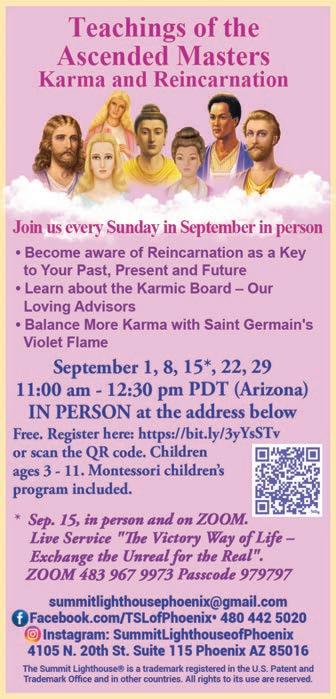

by Carrie Gauthier
The first known reference to yoga is in the Upanishads Sanskrit texts, written 2,500 years ago. The practice originally comprised breath work, and the physical postures developed over time. According to the global data platform Statista, nearly 34 million Americans practice numerous types of yoga, while science continues to provide evidence of its healing potential.
With the frenetic pace of life today, many people live in a permanent state of anxiety. Yoga can ease the panic and malaise by activating the parasympathetic nervous system to decrease stress hormones, blood pressure and heart rate.
“Yoga therapy differs from traditional psychotherapy in scope and aim. Rather than delving into traumas, yoga empowers individuals to be present, moving away from personal narratives,” says Adam Flores, a certified yoga therapist from Port St. Lucie, Florida, specializing in addiction and mental health. “Trained yoga therapists offer grounding techniques and skillful checkins, especially for trauma cases, improving heart rate variability, vagal tone and overall nervous system health.”
A 2011 meta-analysis study published in Primary Care Companion for CNS Disorders indicates that yoga may be an effective

treatment option for severe mental illness, with the added advantage of being less toxic than pharmaceutical treatments.
Post-traumatic stress disorder (PTSD) is a significant issue facing the U.S. military and a growing problem for teens that have experienced violent or traumatizing events. Conventional treatments such as cognitive behavioral therapy and eye movement desensitization and reprocessing have shown limited effectiveness due to high dropout and nonresponse rates. On the other hand, studies have found that engaging in yoga and other mind-body practices can reduce intrusive memories, avoidance and emotional arousal symptoms, as well as anxiety, depression and anger associated with PTSD.
Yoga therapy improves critical factors in addiction recovery, including emotional balance, mental clarity and stress reduction. In a 2021 study published in the Journal of the American Board of Family Medicine, yoga for the treatment of substance abuse disorder was determined to be an effective option.
Yoga has developed into a variety of styles that can meet the goals and objectives of their practitioners. Some of the more popular formats include:
• Vinyasa: An up-tempo class of postures or poses (asanas) often accompanied by high-energy music that typically results in a consistently elevated heart rate. A 2017 study published in The FASEB Journal found that eight weeks of vinyasa yoga improved physical fitness, relieved stress and improved mental well-being.

• Yin: This form of yoga focuses on gentle, passive stretches held for one to three minutes, offering ample opportunity to release stress and tension. Poses are often supported by props such as bolsters, straps, blocks, pillows and blankets. Long, slow, deep breathing promotes relaxation to help the practitioner hold each pose for extended periods of time. Yin yoga stimulates and stretches fascia, the thin connective tissue throughout the body, as well as ligaments and joints, resulting in increased flexibility.
• Hatha: This is a classic yoga style involving breathing exercises and poses that are held for longer periods of time than other formats. Although the slower, more meditative pace may seem easier, holding a proper pose for extended periods of time can be challenging for the body and mind. According to a 2018 study in the International Journal of Preventive Medicine, 12 sessions of hatha yoga significantly reduced stress, anxiety and depression in women.
• Kundalini: This yoga style prioritizes spiritual growth and awareness, with a focus on energy and chakras. Kundalini awakenings are common via movement
sequences, breath work, mantras and chanting. Different studies in 2021 found that kundalini yoga is an effective shortterm therapy for generalized anxiety disorder and can be helpful in reducing the severity of insomnia.
One of the core tenets of a yogic practice is self-compassion, and it is important to resist the inclination for negative self-talk. To adopt the yogic way is to choose happiness over suffering.
“In my experience, the best healing experiences happened by tapping into the body and unlocking the energies we hold onto,” says Paty Renda, a certified Ananda hatha yoga instructor and co-owner of Premah Wellness, in Fort Lauderdale, Florida. “I believe in serious work done through fun exercises such as breath, dance, laughter and movement. A simple, slow and deep hatha yoga practice can create profound changes. Gratitude is another very easy, and yet immensely powerful, practice I infuse into everything I do.”
Carrie Gauthier is a writer in the healing arts with interests in clinical and transpersonal hypnotherapy.
Three-Month Planner
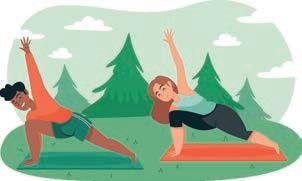
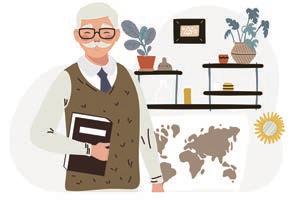
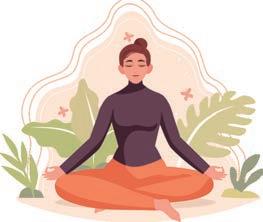
by Zak Logan

For many of us, our hair can feel like an outward expression of our identity, and we may struggle emotionally and socially when it is compromised. According to the National Alopecia Areata Foundation, an estimated 6.7 million Americans suffer or have suffered from alopecia areata (AA), an autoimmune disease resulting in hair loss on the scalp, face and other parts of the body. Whether AA manifests as bald patches or complete hair loss, the conventional courses of action may involve oral prescription medication, over-the-counter topical products and oral or injected steroids that are often unsuccessful and may come with side effects.
There is evidence that stress and anxiety can play a role in AA, as can certain underlying health conditions such as thyroid disease, celiac disease and lupus. Hormonal imbalances and vitamin and mineral deficiencies can also be key factors. Although AA can be a stubborn condition, alternative approaches such as centuries-old Ayurveda and Traditional Chinese Medicine (TCM), including acupuncture, can offer hope.
According to allopathic medicine, AA may be caused by hormonal imbalances or an excessive immune response that attacks the hair follicles, but from the perspective of Eastern medicine, the issue is more complex. Ayurveda, India’s 5,000-year-old holistic-health system, approaches AA and other health conditions from the concept of individual constitution. Energetic forces
called doshas are believed to be inherent in all cells and organ systems and embody five natural elements: earth, air, fire, water and ether.
“Our doshic makeup is very unique, with the ratios between the three doshas (vata, pitta and kapha) being different for each one of us. In alopecia, it is most commonly seen as a pitta condition when the metabolic fires within us are excessive and too hot, causing inflammation,” says Virender Sodhi, an Ayurvedic and naturopathic physician in Redmond, Washington. He adds that for alopecia cases caused by thyroid disorders, in which the hair becomes dry and brittle before falling out, he would look into the health of a person’s vata, the dosha that corresponds to the element of air.
A 2022 case study of an individual AA patient published in Journal of Ayurveda and Integrative Medicine reported that the patient saw improvement within 15 days of an Ayurvedic treatment plan that included a combination of cleansing, detoxification, blood purification and naturally derived medications. The researchers recommended further study of these techniques. Another study published in the same journal a year later noted the effectiveness of certain Ayurvedic medicines comprised of natural elements, combined with cupping, in which heated cups are placed on the back, stomach, arms, legs or other parts of the body, forming a vacuum or suction force.

From the approach of 3,000-year-old TCM, imbalances and illnesses are attributed to obstructions within the body’s subtle energetic system. “This is the concept of the life force, or the energy of our body as it takes care of itself,” explains Brian Keenan, a naturopathic doctor and licensed acupuncturist at Sagelight Integrative Wellness Center, in Columbia, Maryland. “In Chinese medicine, qi is the energy of the body, and it flows along a set pattern similar to a well-connected network of roads and highways. Meridians are the names of the major highways an acupuncturist will use to influence the qi flowing through them.”
In cases of alopecia, Keenan would dive deeply to find the origin of the pathology. “The specifics of your symptoms will help an acupuncturist figure out where exactly the problem is coming from, since there can be several issues at once,” he explains. “This is why your acupuncturist may spend a great deal of time asking you detailed questions about every nuance of not just your symptoms but also your whole body’s health.”
A 2022 review of eight studies published in Frontiers of Medicine found that acupuncture or moxibustion (the burning of dried mugwort on or near the body during acupuncture), used by themselves or in combination with other treatment modalities, may be effective in treating hair loss.
September is “Dimensions of Balance” Month!
Clinical findings published in the Indian Journal of Dermatology in 2017 report that systemic vitamin D levels are lower in people with AA, and improvement might result from supplementation. Recent research also shows that zinc deficiency was noted in sufferers and adding the mineral to the diet might be helpful. Mount Sinai Health System, in New York City, suggests that biotin and trace minerals might foster hair growth and recommends including beneficial foods such as carrots, tomatoes, chard and romaine lettuce.
Practitioners of both Ayurveda and TCM attest to the value of eliminating processed foods as a way to support the liver in its role of minimizing systemic inflammation. They also recommended streamlining busy schedules and employing meditative practices to reduce stressors.
For best results, commitment is key. Regarding TCM, Keenan suggests an eight-week treatment plan of herbs and acupuncture. “Is it possible to see results sooner? Absolutely. But from my experience as a practitioner, it’s better to set realistic expectations, and if we get there sooner, then that’s all the better.”
Zak Logan is a freelance health writer dedicated to holistic living.
From September to December, celebrate the Holiday Season at the Dimensions Holiday Bazaar, with events for the whole family!
Intuitive Development Classes to enhance your connection to Spirit
Relaxing Crafting Workshops to spark your creativity
Guided Meditations and Sound Baths for your Mind, Body and Soul
Gift Specials Every Day and Small Business Weekend 11/30-12/1
Check out the latest events at naturalaz.com/calendar
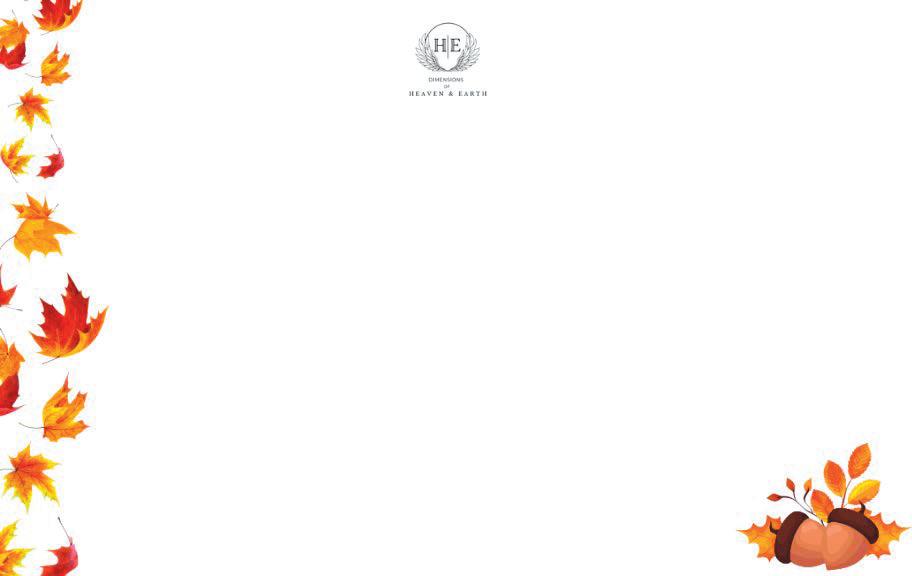
by Malissa Stawicki
Emotional health is a key component of overall well-being, reflecting a person’s ability to manage their emotions and adapt to life’s changes. It’s an essential aspect of both mental and physical health.
Mental health refers to any condition diagnosed as a disorder, such as eating disorders, bipolar disorder and schizophrenia. With the significant rise in mental health diagnoses today, it’s crucial to ask: What factors are causing this increase and how can it be prevented?
To explore this topic further, several holistic practitioners were interviewed to provide their perspectives and offer suggestions for empowering individuals to take positive steps toward healthier emotional well-being.
Mary Ann Doyle, a Thought Field Therapy Therapist, explains that Thought Field Therapy (TFT) is an energy-based form of psychotherapy designed to reduce symptoms of psychological distress by manipulating how energy flows in the body. TFT is based on the premise that bodies consist of energy fields and that imbalances in this system cause physical and emotional issues. According to Doyle, TFT can have rapid and lasting results in treating various psychological conditions, including anxiety, trauma, phobias, depression and addiction.
Says Doyle, “As I reflected on this, I realized that first, we all need to set our intention that we want to feel better; we don’t want to continue to repeat a problematic cycle of behavior that gets us nowhere. And what I’ve discovered over the years is that often in treating a trauma, it leads back to childhood experiences that cause triggers, flashbacks, nightmares and a dysfunctional pattern of living, to cope with what you lived through as a child.
“Thought Field Therapy allows you to heal from those traumatic events,” continues Doyle. “But you must decide and recognize what that pattern is, and, what you want to do about it. You can get relief, and you can unlock those triggers, so they no longer affect your daily living and increase your well-being, your ability to sleep, and your relationships to others. Because as you heal, you find strength and happiness within yourself.
“I’ve worked with children and adults for over 25 years,” she adds. “Many of the adults I’ve worked with have manifested physical disease. And really, when you think about that word, it’s ‘dis-ease’—not at ease within yourself, your body or your mental state. Anomalies

that happen in the body are connected to unhappiness, to feelings of despair, to a constant state of anxiety, and so on. Mental health goes hand in hand with medical conditions you might be working with. Thought Field Therapy allows you to heal from the trauma that quite often is built up over the years and creates physical wellness.”
Acupuncturist David Garcia believes Chinese medicine is an integral part of a comprehensive approach to emotional health. “In Chinese medicine, we use all parts of the body as one, and, of course, the emotions are in there too,” he explains. “There definitely is an interaction between body, mind and spirit. Through acupuncture or herbal remedies, we can help balance a lot of different emotions so we can better control them. Emotions are natural, and they serve a purpose, but when they get out of hand, they become a problem. Finding natural ways to help control them gives yourself a little bit of an edge so that you’re able to get through difficult times. Acu-detox, which is acupuncture in the ears, is known for its calming effects and works immediately. When we are out of fight-or-flight response, it helps a person to make better decisions.”
Garcia notes that Chinese herbal medicine can also be very effective for emotional health because it works with the organs, as traditional Chinese medicine associates different emotions with specific organ systems: sadness and grief with the lung, anger with the liver, fear with the kidney, joy with the heart, and worry with the spleen.
“In Chinese medicine, the heart is in control of joy,” says Garcia. “When we don’t have joy in our life, it allows all the other emotions and bad situations to take a bigger grip on us. So being able to give herbs that can stimulate and help the heart in terms of energetically to flow better, it can help us have more joy. There are herbs that benefit the liver system, and the liver has a lot to do with frustration and anger. A lot of times when the liver system gets out of hand, that energetic imbalance disrupts other systems in the body, such as the spleen. I mean, when we’re angry all the time, it takes away our joy and creates confrontation, which makes it accelerate more and throws off the energetic harmony of the body. There are many herbs that can help a person find good emotional health.”
Suesan Johnson, a classically trained homeopath, uses this gentle, noninvasive approach to relieve symptoms associated with depression, anxiety and trauma. Homeopathy is appropriate for all ages, easily administered, and has no harmful side effects.
“I would like to start by saying being nervous, uncomfortable and having some anxieties is normal,” says Johnson. “Whether it’s a job interview or getting ready for an upcoming vacation, all those things can cause some anxiousness or nervousness and are normal within range. However, if those emotions interfere with your daily life, such as not wanting to drive because there’s too much traffic and you get nervous driving, or not wanting to see people because you maybe have a phobia of going out, these are some examples of when a homeopathic consultation could be helpful.”
When addressing specific homeopathic remedies for emotional distress, Johnson says several options stand out for their effectiveness:
Aconite: Used for something that happened very suddenly, like a car accident, that you’re not able to overcome.
Ignatia: Used for those suffering from a great loss or grief.
Arnica: Used for trauma—physical, mental and emotional—such as from an accident.
The insights provided by these holistic practitioners underscore the diverse approaches available for enhancing emotional well-being. Whether through Thought Field Therapy, Chinese medicine or homeopathy, each method offers unique benefits for addressing and managing emotional distress.
Malissa Stawicki is a holistic health advocate at Natural Medicine and Detox, in Phoenix. She promotes nutritional wellness and organizes classes on healthy eating. Many studies have shown a direct correlation between what is eaten and the emotional state of the person. To set up an appointment, call 602-307-0888. For more information, visit NaturalMedicineDetox.com. Sign up for the newsletter to receive updates on free in-person classes on how to have the best health with food. See ad, page 9.
Advertorial

by Christina Connors
The mental health of our children is in crisis. According to the U.S. Surgeon General’s 2021 advisory on the youth mental health crisis, one in five children aged 3 to 17 has a mental, emotional, behavioral or developmental disorder.
To turn the tide on mental health, kids need emotional regulation skills, including the ability to identify emotions, self-soothe, obtain perspective, walk in another’s shoes, think flexibly and solve problems. By developing these emotive sensitivities, children can then improve their self-confidence, sense of self-worth and empathy, as well as begin to develop lasting and meaningful relationships.
“Kids will learn to regulate in the face of challenge. The only question is whether they learn healthy or unhealthy ways to do it,” says Brad Chapin, a licensed clinical psychologist in Topeka, Kansas, and author of self-regulation resources for children. “Removing challenges from children isn’t the answer. The focus should be on building self-regulation skills, and then those challenges become opportunities for strengthening those skills.”

In the words of lyricist Stephen Sondheim, “Careful the things you say / Children will listen.” Janet Philbin, LDSW, a certified, conscious-parenting coach and author, says, “When people become parents, they will tell you they want to parent differently than how they were parented because of the emotional childhood pain they endured. However, generational patterns will more than likely repeat unless the parent has done the emotional work to deconstruct their own childhood pain through coaching or counseling. As a result of doing the necessary inner work, a parent’s ability to connect with their children will improve because they are able to be more connected with themselves.”
“When we choose to look at behavior issues as a lack of skill-development, it changes the story from one of shame and negativity to one of hope,” says Chapin, whose recent book Self-Regulation Skill Set supports adults in their journey to self-regulation.
As with learning any new skill, practice is key. Here are a few fun activities for parents and children to do together to


strengthen connections and build emotional regulation skills. Teaching kids when they are young is ideal, but it is never too late to start.
I Spy: While in a store, on a walk or at a park, challenge each other to notice the body language and facial expressions of people (or themselves) and identify the emotion they might be feeling. This game is a way to practice the skill set of recognizing warning signs when we start to feel upset. Parents should encourage their kids to take notice of the different expressions their peers make while at school to develop empathy and compassion.
The Paws (Pause) Game: To play, the first person who sees a dog says, “paws”, takes a calming breath and puts their hands out like paws. The person with the most points at the end of the excursion wins. This game develops the skill of slowing down the alarm system within our bodies. Parents and caregivers can remind kids that throughout the day when they start to feel their own warning signs of anger or frustration, they can take a breath and “paws” to help prevent acting in a destructive way.
Balloon Party: In this game, parents invite their kids to sit comfortably with them and imagine that they are all preparing for
a big party and need to blow up lots of balloons. While blowing up pretend balloons, remind each child to blow them up slowly so they don’t pop. After blowing up several balloons, enjoy a pretend party. This is a fun way to connect with children through imaginative play while practicing peaceful breathing, which helps calm the nervous system.
Christina Connors is a writer, singer and creator of Christina’s Cottage, a YouTube series to strengthen kids’ resilience, connection and joy through music, mindful play and the power of the heart. Learn more at ChristinasCottage444.com.
by Ruth Roberts, DVM, CVA, CVH, CVFT, NAN
Pet therapy, also known as animalassisted therapy (AAT), has long been recognized for its therapeutic benefits across a range of mental health conditions, including post-traumatic stress disorder (PTSD). Psychiatric service dogs are empathetic in nature and intuitively respond to human emotions. These capacities allow them to provide comfort and support precisely when it’s needed, often without the need for verbal communication. These dogs are not just pets but vital partners in the journey toward mental and emotional healing.
Interacting with psychiatric service dogs can reduce anxiety and stress levels by increasing the release of oxytocin, a hormone associated with bonding and stress reduction, while decreasing cortisol levels, which are linked to stress.
Psychiatric service dogs provide a calming presence, which is crucial for reducing anxiety and hypervigilance, common symptoms of PTSD. A study published in Frontiers in Psychology involving 134 veterans with service dogs found that trained skills such as calming and interrupting anxiety are highly valued by veterans with PTSD, suggesting their critical role in daily PTSD management. The study also noted that untrained behaviors of the dogs are often perceived as more beneficial than their trained tasks, highlighting the intrinsic value of simply having a dog as a companion.
A 2022 study of 82 post-9/11 military veterans published in PLOS ONE reported that their psychiatric service dogs helped them with PTSD by performing calming actions and interrupting the veterans’ disturbing behaviors and thoughts during anxiety episodes. Researchers noted that all of the tasks the dogs had been trained to perform were used daily by the veterans, providing benefits for nearly all PTSD symptoms, except amnesia and reckless behavior. The humananimal bond and untrained qualities, such as companionship, also significantly improved the participants’ symptoms and quality of life.
Psychiatric service dogs enhance emotional regulation and improve social interactions
for PTSD sufferers. Their non-judgmental and accepting nature creates a safe space for individuals to explore and manage difficult emotions. Additional research reported in the European Journal of Psychotraumatology demonstrated significant improvements in emotional and attentional regulation among adolescents with PTSD that were asked to participate in a one-year dogtraining program.
While the therapeutic benefits for the handlers are significant, the European Journal of Psychotraumatology study also noted that the dogs in the training programs exhibited increased anxiety and decreased attention. This highlights a critical aspect of AAT: The welfare of the animals must be considered alongside the therapeutic benefits. Training programs need to ensure that the dogs are not overly stressed or burdened by their roles.
Prospective handlers of psychiatric service dogs should choose programs that prioritize the well-being of both dogs and humans through training, support and follow-up care. Engaging with a psychiatric service dog is a significant commitment that requires handlers to invest time in training and bonding with their dogs, as well as

managing their emotional and physical needs to ensure a mutually beneficial relationship.
Understanding the legal rights pertaining to psychiatric service dogs, including accessibility in public spaces and accommodations, is crucial. Handlers should educate themselves about local and national laws that protect their rights and those of their service dogs.
Obtaining a psychiatric service dog involves careful consideration of the therapeutic benefits versus the potential stress on the animal. Look for reputable programs that train dogs to assist individuals with PTSD, while also prioritizing the welfare of the dogs and properly matching dogs and handlers.
The integration of psychiatric service dogs into mental health care offers more than just companionship; it opens a dynamic pathway for healing and managing PTSD symptoms. As we continue to explore and understand the unique bond between humans and animals, it becomes increasingly clear that dogs are not only cherished pets but also invaluable partners.
Ruth Roberts is an integrative veterinarian and holistic health coach for pets, as well as the creator of The Original CrockPet Diet. Learn more at DrRuthRoberts.com.




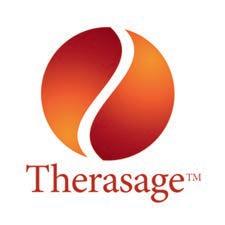
Therasage is the gold standard for energy healing, naturally healing infrared, negative ions and eliminating EMFs.
Therasage.com
Scan to register for educational webcast to learn more.


A NEW fun and interactive series dedicated to the health and well-being of Preschoolers and their families.
WORLD MUSIC, MOVEMENT, MINDFULNESS, CREATIVE PLAY, TIME IN NATURE & POWER OF THE HEART! SUBSCRIBE today!
Scan to learn more and subscribe.


Founded in 1932, Boiron, the world leader in homeopathic medicines, is best known for its popular Arnicare® line of pain relievers and Oscillococcinum® flu reliever.
BoironUSA.com
Save 20% with code NA20



OB/GYN-formulated
Rejuvenates vaginal tissue, restores natural moisture, and helps prevent bladder leaks.
DrAnnaCabeca.com/ products/julva

Connecting you to the leaders in natural health care and green living in our community. To find out how you can be included in the Business Directory, email PhoenixAds@NaturalAZ.com to request our media kit.
MacKenzie Kalt, Owner/Director 4050 E Greenway Rd, Ste 5, Phoenix
480-594-5052
MyLeadingEdgeWellness.com

Providing some of the most advanced natural technologies for those struggling with chronic pain, injuries, stress, migraine headaches, PTSD, insomnia, Lyme disease, autoimmune disorders, skin conditions, and much more. Visit our website to learn more. See ad, inside front cover.
NATURAL MEDICINE & DETOX
2701 N 7th St, Phoenix
602-307-0888
NaturalMedicineDetox.com

We offer a wide range of services that can help just about everyone at affordable prices. We also accept insurance for acupuncture, including Medicare. Please take a look at our website to learn about our services, gifted practitioners, and insurance information and form to see if your plan covers acupuncture. See ad, page 9.
WATERCOLOR ART CLASSES
Allura Westly 3611 E Sunnyside Dr, Phoenix AlluraWatercolor@cox.net 602-469-0524 • AlluraWaterColor.com

Allura Westly, master teacher, opens her sanctuary studio to all levels, beginner to advanced. Learn fluid color technique, drawing and composition. Small class of eight students. No talent required, just a desire to create.
MODERN WELLNESS
Denise Cahill, CNC
Scottsdale
480-640-9755
Bio-Scans.com

Modern Wellness offers inperson and remote biofeedback scans to test for imbalances within the body, identifying the root cause of symptoms and health challenges. Specific remedies and action plans are discussed. A holistic approach to health is discovering and eliminating the root cause to truly heal. Practitioner collaboration welcomed.
ALLY SPINE CENTER 10565 N 114th St, Ste 109, Scottsdale 480-809-4700 asc.drc2000@gmail.com AllySpineCenter.com

Dr. Chris Condon utilizes stateof-the-art techniques and technologies including non-surgical spinal decompression with the SpineMed and SUMMUS class 4 medical laser for the correction of degenerative spinal conditions including stenosis, herniated/bulging discs and neuropathy as well as knee decompression with the Knee On Trac.
NATURAL DENTAL PARTNERS 6930 E Chauncey Ln, Ste 100, Phoenix 602-775-5120 • MyNaturalDentist.com




The doctors at Natural Dental Partners take the time to listen to your concerns and use their extensive experience to help you achieve better health. Using the latest technology (such as low-dose 3D imaging, CEREC, lasers, PRF, ozone and treatment of sleep disorders), they believe in a team approach to help you achieve your healthcare goals. Check out MyNaturalDentist.com or ABreathOfHealth. com to see how they can help you. See ad, pages 3 and 13.
Eddie, Harsini, DDS 7102 W Thomas Rd, Phoenix 602-385-8732 • PhoenixImplantClinic.com

Emphasizing a holistic approach to dental health, Dr. Har sini and his team have a reputation for pain-free procedures and comprehensive postoperative care, with meticulous attention to detail and a patient-focused philosophy. The clinic uses technologically advanced practices, ensuring the best possible results time after time. See ad, page 31.
Dr. Josh Raiffe, DMD, AIAOMT 11111 N Scottsdale Rd, Ste 120, Scottsdale 480-998-3923
SheaDentalAZ.com

Shea Dental offers holistic dentistry led by Dr. Josh Raiffe, DMD, AIAOMT Accredited. Using advanced technology like CEREC milling, digital impressions, Wand anesthesia, cone beam CT scanning, and SMART mercury filling removal, Dr. Raiffe ensures safe dental practices. Services include implants, veneers and sleep apnea treatments. Accepts most dental insurance. See ad, page 5.
KIM CARTER, MA, HTCP 15215 S 48th St, Ste 154, Phoenix Kim@IntuitiveKim.com IntuitiveKim.com

Kim is an Intuitive and Healing Touch Certified Practitioner offering guidance when you feel out of alignment with your authentic self. Stress, fear, anxiety and grief/loss throw us off balance, making it challenging to access inner wisdom. Sessions include reading and clearing your energy field; and simple, practical selfhealing tools to keep you balanced and grounded. See ad, page 32.
HOLISTIC ENERGY ACADEMY
13291 W McDowell Rd, Ste E-1, Goodyear 623-935-0501
TJHofgard@gmail.com
LavendarMoonStore.com

Make a Difference Doing What You Love! Become a Professional Holistic Health Energy Practitioner. Learn the most effective and comprehensive energy modality and techniques with proven results. Become trained in the body’s many energy systems; learn how to energy test, clear, restore, detect and correct energy imbalances. Levels I, II and III.
YOUR LIFE WELLNESS CENTER
931 E Southern Ave, Ste 106, Mesa 480-306-7321
RealignYourLifeAZ.com

Realign Your Life Wellness Center features the Harmonic Egg—sound and light therapy for physical, emotional and spiritual energy healing. Other services include The Body Code, Life Force Energy with Sound, sound baths and Higher Guidance Life Coaching. See ad, page 32.
OSTEOSTRONG
8120 N Hayden Rd, Scottsdale
Text/call 602-932-2792
OsteoStrongScottsdale.com

OsteoStrong is a leader in natural bone health and wellness with centers in Phoenix (Arcadia) and Scottsdale (McCormick Ranch).
Our member s report significant improvements in osteoporosis, physical strength, balance and posture in 15 minutes a week. Specializing in osteogenesis without drugs, we’re dedicated to holistically enhancing quality of life. See ad, page 17.
NORTHWEST EXTERMINATING Organic Program Experts 623-516-2220
NWExterminating.com

We have organic alternatives available w ith multiple programs to meet your needs. Ask us about our year-round pest protection, SMART ecofriendly rodent control 24/7 home protection, and desert guard home sealing service. See ad, page 25.
ANDREA BRIGGS, AKA “CRITTER DOC”
ASAM, Sh Reiki, HTAP Communicator, Healer, Counselor 602-317-1543
1CritterDoc@gmail.com
SpiritAnimalWisdom.com

With a gentle healing touch, Andrea provides wellness counseling, energy healing, animal communication, and intuitive counsel for pets and their people.
FENG SHUI REAL ESTATE
Jennie Richau
Associate Broker and Certified Feng Shui Consultant, Brokers Hub Realty 602-292-0622
• WooWooAgent.com

A unique and holistic way to buy or sell! Utilizing Feng Shui and various "woo woo" methods to find you a home where you will thrive or sell your home quickly, for the highest value. See ad, page 17.
SOUTHWEST INSTITUTE OF HEALING ARTS
1538 E Southern Ave, Tempe 480-994-9244
Info@swiha.edu • swiha.edu

Nationally accredited college offers holistic health and wellness degrees, diplomas, certificates of excellence, continuing education and personal development, oncampus and online. Financial aid available. See ad, outside back cover.
DIMENSIONS OF HEAVEN AND EARTH
11108 N Frank Lloyd Wright Blvd, Ste E16 Scottsdale 732-832-1036
DimensionsOfHeavenAndEarth.com

Dimensions of Heaven and Earth is Scottsdale’s exciting, new one-stop Spiritual Experience: a center of healing and insight combined with a store full of unique gifts from local artisans. With training and tools for your personal development, we are excited to help you take your spiritual journey to new levels! See ad, page 29.
The Path of Spiritual Freedom 1-877-300-4949 • EckankarArizona.org Eckankar.org • HearHU.org Facebook.com/EckankarArizona

Eckankar is an active, individual, creative spiritual practice. A companion and roadmap for your journey home—to the heights of Self-Discovery and GodDiscovery, and beyond. Come along and discover the most secret part of yourself. The key to spiritual freedom lies within you. Explore life as a Soul Adventure. See ad, page 9.
4105 N 20th St, Ste 115, Phoenix 480-442-5020
SummitLighthousePhoenix@gmail.com
SummitLighthousePhoenix.org

Dedicated to sharing Saint Germain’s Violet Flame. All faiths welcome. Learn how you can become a modern day mystic. We are dedicated to sharing the Teachings of the Ascended Masters® to help you bring in joy and peace to the world. Learn what the requirements are to make your ascension. See ad, page 25.


Soul Heart Collaboration 2024 Annual Retreat Theme: "Infinite Possibilities"
Global Event – October 4-6 18 Speakers. 8 Countries. 10+ Hours. Join us in person in Scottsdale, AZ. Wisdom. Friendship. Opportunity. All Access Pass: Virtual + In-Person + All Recordings = Investment: $150 USD. That’s just $8.33/speaker. Info@SoulHeartCollaboration.com SoulHeartCollaboration.com

AIHM, SCU & CORNERSTONE COLLABORATION
Invite You to the FIRST ANNUAL WHOLE HEALTH CONFERENCE BRINGING WHOLE HEALTH TO LIFE
OCTOBER 25-27, 2024
San Diego | Paradise Point Resort & Spa


SCAN FOR TICKET


October 25-27, 2024 • Renaissance Orlando at SeaWorld
Three-Day Conference with Five Farm-to-Table Meals ($450 members; $500 non-members)
One-day and two-day registration passes available



40 speakers • 75 exhibitors • 1200 attendees
Saturday Night Banquet • Volunteer Opportunities
Optional:
Thursday Evening: Real Milk Celebration Dinner
Monday: Farm Tour with Will Winter and Steve Campbell CEUs for nurses, acupuncturists & NANP nutritionists • Children’s program Register today at wisetraditions.org


NOTE: Please check market websites and ArizonaCommunityFarmersMarkets.com for more information on days and hours, and any restrictions.
Ahwatukee Farmers Market
4700 E Warner Rd, Phoenix
Sundays Oct-May 9am-1pm Jun-Sep 8am-11am
Facebook.com/AhwatukeeFarmersMarket
Care 1st Farmers Market
328 W Western Ave, Avondale
Tuesdays Jul-Oct 8am-noon ArizonaCommunityFarmersMarkets.com
Carefree Farmers Market
1 Sundial Circle
Fridays Oct-May 9am-1pm Jun-Sep 8am-11am
Facebook.com/CarefreeFarmersMarket
Downtown Chandler Farmers Market
3 S Arizona Ave
Saturdays Oct-May 9am-1pm Jun-Sep 7am-10:30am Facebook.com/ChandlerFarmersMarket
Downtown Mesa Farmers Market
1 E Main St
Saturdays 8am-noon dtMesaFarmersMarket.com
Downtown Phoenix Farmers Market
721 N Central Ave
Saturdays Oct-Apr 8am-1pm May-Sep 7am-11am DowntownPhoenixFarmersMarket.org
Gilbert Farmers Market
222 N Ash St
Saturdays Oct-Mar/Apr 8am-noon
Apr/May-Sep 7-11am GilbertMarket.com
High Street Farmers Market
5415 E High St, Phoenix
Sundays Oct-May 10am-1pm
Facebook.com/Farmers-Market-on-HighStreet-2244771575799425
Mommas Organic Market
Arrowhead Farmers Market
7780 W Arrowhead Towne Center, Glendale
Saturdays Oct-May 9am-1pm | Jun-Sep 8-11am
Facebook.com/Getlocalazfarmersmarkets GetLocalArizonaEvents.com
Mommas Organic Market
Glendale Farmers Market at Cabela’s 9380 W Glendale Ave, Glendale, AZ 85305
Sundays Sep-May 10am-2pm | closed for summer Facebook.com/Getlocalazfarmersmarkets
GetLocalArizonaEvents.com
Old Town Scottsdale Farmers Market
3806 N Brown Ave
Saturdays 8am-1pm
ArizonaCommunityFarmersMarkets.com
Power Road Farmers Market
4011 S Power Rd, Mesa
Monday-Saturday 9am-5pm | Sunday 9am-4pm PowerrdFarmersMarket.com
Roadrunner Park Farmers Market
3502 E Cactus Rd, Phoenix
Saturdays Oct-May 8am-1pm | Jun-Sep 7-11am
Facebook.com/RoadrunnerParkFarmersMarket
Singh Meadows Farmers Market
1490 E Weber Dr
Fridays, Saturdays & Sundays 8am-2pm Facebook.com/SinghFarms



Sun City Farmers Market 16820 N 99th Ave
Thursdays Oct-May 9am-1pm
Facebook.com/Sun-City-Farmers-Market631299790224049
The Capitol Farmers Market
1700 Adams St, Phoenix Thursdays 10:30am-1:30pm ArizonaCommunityFarmersMarkets.com
Uptown Farmers Market 5757 N Central Ave, Phoenix
Wednesdays Oct-Apr 9am-1pm & May-Jun 8am-noon
Saturdays Nov-Apr 9am-1pm & May-Oct 8am-noon UptownMarketAZ.com
Verrado Community Farmers Market N Market Pl & W Main St, Buckeye Sundays Oct-Jun 9am-1pm Facebook.com/VerradoCommunityFarmersMarket
Farmers Market in Old Town Square 1042 N Main St, Cottonwood Wednesdays 4-8pm (check months/times throughout year)
Facebook.com/FarmersMarketatOldTownSquare
Flagstaff Community Farmers Market 211 W Aspen Ave, City Hall Parking Lot Sundays May-Oct 8am-noon FlagstaffMarket.com
Prescott Farmers Market
Dignity Health, YRMC 900 Iron Springs Rd, Miller Valley Lot Saturdays 7:30am-noon PrescottFarmersMarket.org
Sedona Community Farmers Market
Wells Fargo Bank Parking Lot 2201 W State Rte 89A, West Sedona Sundays May 14-Oct 15 8am-noon | Sundays Nov 5-Apr 28 11am-3pm Sedona-Farmers-Market.com
Verde Valley Farmers Market Hollamon St and Main St, Camp Verde Saturdays May-Oct 8-11am Facebook.com/VerdeValleyFarmersMarket
Windmill Park Farmers Market 9950 E Cornville Rd, Cornville Thursdays 2-6pm (check months/times throughout year)
Facebook.com/WindmillParkFarmersMarket




